May 15, 2004
Thanks Mark!
A hearty thanks from Jerry Beck and myself to Mark Mayerson for being our first guest contributor, and a superb one at that. Over the past few weeks, I've enjoyed reading his insightful perspective on the TV animation biz, and we've heard from numerous other folks thanking us for his pieces. Thanks again to Mark and stay tuned for our next guest contributor who we'll be announcing soon.
Katzenberg Genius Moment of the Week
Here's a photo of Will Smith, Angelina Jolie and Jack Black at the Cannes Film Festival riding atop an inflatable SHARK TALE pool toy. And there's still five months until this film is released. Boy, this is going to be a lot of fun.
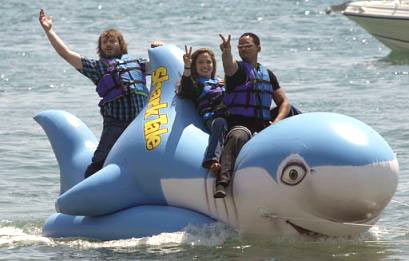
May 14, 2004
Lots of Mickey Mouse statues headed for Portland
More than a dozen 700 pound statues of Mickey Mouse will soon appear in Portland, Oregon, as part of a year long Disney Company nationwide tour, "Celebrate Mickey: 75 InspEARations". Read about it here.
INCREDIBLES TRAILER
 |
A new trailer for Pixar's The Incredibles is up - posted here - and it's hilarious. Any doubt that this will be anything less than a blockbuster?
Go, Pixar, go!
Thanks and Some Requests
This is going to be my last contribution to Cartoon Brew. I’d like to thank Jerry and Amid for having me as a guest for a few weeks and I hope that my contributions were useful to somebody.
Having talked in generalities about TV animation, I’m now going to get specific and talk about myself. Monster By Mistake has wrapped up production and now I’m writing new scripts and pitches which I’ll be taking into the marketplace later this year.
One market that I hope to crack is the direct-to-video computer animated feature. I’ve got a script for one ready to go and another script in progress. If there are any home video producers reading this (or for that matter, any feature producers) who’d like to see the material, please contact me through the Catapult Productions website (which is way overdue for an update; that’s what happens when you’re neck deep in production).
Another goal I have is to find an agent. I’m not interested in an agent to rep me as a writer-director so much as I am interested in an agent to represent Catapult Productions as we try to launch new properties for TV, home video and (someday, please!) films. If there are any interested agents out there or folks with representation who might be willing to give me a referral, please contact me through Catapult Productions.
Once again, thanks to Jerry and Amid for a great website and for giving me the opportunity to be part of it. -Mark Mayerson
Directing TV Animation Part 3
It’s rare in TV animation these days for the director to be in the same location as the animators. On Monster By Mistake, we were lucky to do the first 26 episodes entirely under one roof. For the second 26, I was able to keep the animation local, though the modeling and lighting were done elsewhere.
When working with a group of animators, a director soon learns their strengths and weaknesses. Some are better at dialogue than action. Others are better at comedy than emotion. Ideally, each sequence should have a reason for being in a show and the director’s job, through casting animators, is to put that reason across to the audience as strongly as possible.
There are live action directors who claim that casting is the most important part of their job. If you get the right performers for a role, you’ve solved most of your problems. Sadly, in TV animation, casting the animators isn’t seen as a priority. Usually, when an animator needs more work, the animator is just handed whatever is ready to go.
When the director and the animators are not in the same country, the director has no input into animator casting. It may be done by an overseas supervisor or by a manager of the subcontracting company, but it might be ignored. The director is left trying to create performances by remote control, using various methods of pre-production.
Poses come from the storyboard and layouts. More poses may be added on the exposure sheets by the sheet timer. The problem with this approach is how poses are timed. Because animation has been going overseas for so long, many sheet timers actually have no experience animating. They tend to play it safe on timing. Also, there’s a lag between timing the sheets and the animation coming back. Often the sheet timer is already off the production when the animation returns, so there’s no chance to learn from mistakes and improve timing for later episodes.
There’s no question that when a director is able to work in close contact with animators you get a better result. It’s a shame that this has become a luxury in the TV animation business.
Cat-astrophic Cartoons
I think I've spotted the big new trend in CG animation: eerie, quasi-realistic looking orange cats. Alright, it's only SHREK 2 and GARFIELD: THE MOVIE so far, but I'm betting the rest of Hollywood will catch onto this exciting fad before the year is out.
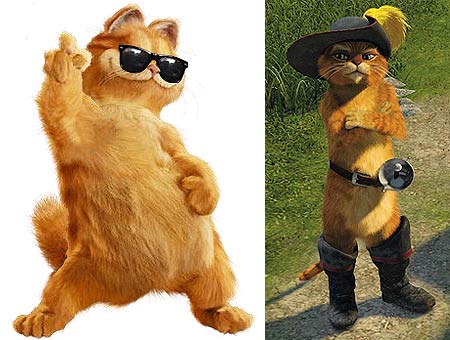
AAAGGH! MY EYES!
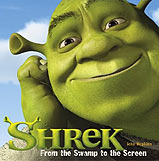 |
May 13, 2004
ASTRO BOY PLAYSTATION GAME
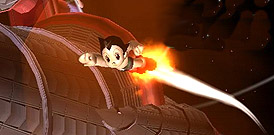
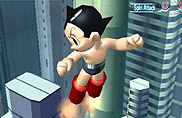
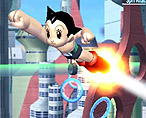
I'm not into video gaming, but I am into classic cartoon characters. Images from the forthcoming Astro Boy Playstation game look pretty cool. Click here for more frame grabs.
FOLLOW-UP: JONES MURAL SAVED!
This just in from John Tebbel:
Great news. The power of Chuck Jones triumphs.Due to the pitching in of lots of folks, chief among them Mr. James Braby of Ernest Neuman Co., an art conservator, who donated their time and expertise to remove the murals and make them safe for moving, the Chuck Jones conference room murals we identified a week ago are going to be saved.
The outpouring of attention from everyone who heard of it, especially some of the donors to educational non-profit New Visions for whom Jones sketched the murals on conference walls in a fit of inspiration in 1988, makes it possible for New Visions to change their plans and make a proper home for the works in their new headquarters across town.
Without these donors stepping forward they wouldn't have been able to keep it; saving conference room artworks isn't part of their mission statement. To put it another way, this is sort of like re-uniting Shirley Temple with that scruffy terrier she offered to sell to get that operation for her father.Thanks Jerry, thanks to Jones fans everywhere.
The Jones Mural even made today's New York Daily News
NBC-UNIVERSAL
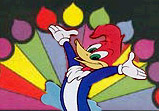 |
NBC-Universal is the only megacorp that doesn't have an animation programming commitment. NBC has no animation production or kidvid block (They run Discovery Kids programing on Saturday mornings) and Universal is content to just churn out LAND BEFORE TIME sequels ad infinitum, so this corporate combo's possibilities are not very exciting to us.
Could NBC-Universal start a competitive animation channel with their Walter Lantz library, Land Before Time movies and connection to Dreamworks? They could, but why bother?
Click here for an interesting AP photo - the kid wearing the SHREK shirt is not out of line: Universal Theme Parks have SHREK attractions and Universal distributes Dreamworks features.
Directing TV Animation Part 2
Directors don’t always have input into character designs for a TV series, but they should. There are many design issues that have enormous impact on production. Design is far more than how a character looks.
In drawn animation, the amount of pencil mileage – the number of lines on a character – has a direct effect on how long it takes to do a drawing. The number of colors on a character determines how quickly color can be applied, whether it’s by hand or by a digital system. Both of these things have an enormous impact on the schedule. If each image of a character is going to take a long time to produce, you’re going to get less animation.
In computer animation, a big issue is intersections. While 3D characters look solid, there's nothing to stop one surface from penetrating another. A character can easily push his hand through a table or his own body. When you’re dealing with capes, skirts or long hair, you have to be concerned about the potential for intersections. Even something as simple as the design of a character's neck might lead to intersections when the character talks or moves his head.
The more time the animators spend fixing intersections, they less time they’re spending on new animation. Being human, animators will often avoid moving something if they know that it will end up causing intersections and slow them down.
Non-artists don’t realize that a design implies a style of motion. The audience expects a realistically designed character to move in a realistic fashion. This takes more time than moving a character in a stylized fashion. If you have a conflict between the level of realism in the design and in the motion, the audience doesn’t perceive the character as believable. While a viewer might not be able to articulate it, the viewer knows that things just aren’t right.
Drawn animation deals with this fairly well due to experience. There’s been a resurgence of UPA style design in shows like Dexter’s Laboratory or The Fairly Oddparents because these designs can be moved in a stylized fashion that fits well with TV budgets. Even drawn action-adventure cartoons, such as the ones that Bruce Timm has designed, are stylized. Besides the visual appeal of the designs themselves, they also work with the quality of animation that will be done for the budget.
Computer animation on TV is still grappling with this issue. Certain shows, like Angela Anaconda and several pre-school shows, have taken the stylized design route and use animation that matches the design style well. CGI action adventure shows like Max Steele or Roughnecks: The Starship Trooper Chronicles have gone with a more realistic design that the animation couldn’t live up to. These shows have failed to catch on with audiences and I think that the gap between design and motion styles is at least partially responsible.
May 12, 2004
CARTOON SUSHI
 |
Enjoy Hamtaro, Doremon, Hello Kitty, Powerpuff Girls in a new way, for lunch! Images Here!
Tim Biskup's 100 Paintings
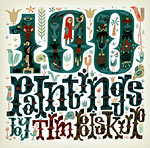 |
"VICTORY" IN DC
 |
On Sunday May 23, at the AFI Silver Theatre in Silver Springs Maryland, Dave will be hosting a 35mm screening of the feature VICTORY THROUGH AIR POWER and several wartime Disney shorts. This will be the only east coast public showing of these films. For more information, go here (this screening was set up so fast, the info hasn't been posted on the website yet).
Directing TV Animation Part 1
The job of directing an animated TV show varies with each production. There’s no single way to approach it and how much power a director has will vary enormously. What I want to talk about in these articles are some of issues that directors have to deal with.
First, let’s talk about live action direction for TV. The director’s job is to communicate to the actors how something should be played. The director deals with how a scene is staged for the camera and where the camera is located for each shot, all the time keeping pacing in mind.
In animation, the job is very different. Depending on the production, there may be a recording director who’s responsible for recording voice tracks for all episodes. There may be a storyboard supervisor, who’s responsible for directing the boards for all episodes. There may also be a timing supervisor who oversees the sheet timing for the show. Depending on the budget, the production may have a layout supervisor to oversee layouts. In other cases, layouts are done overseas.
The director may participate in all these aspects, providing notes or approvals, but won’t be doing the work himself or herself. The animation will be sent someplace (probably in Asia) to be done and then the director will call retakes for scenes that have mistakes or need to be revised. The director will probably never meet the animators and depending on the production, may never meet the voice talent either.
In live action TV, the director has his or her hands on everything and is communicating directly with the people doing the work. In TV animation, the director is often separated from the people doing the work by levels of bureaucracy or by thousands of miles.
Sick of Indian Animation Yet?
An enlightening interview with the heads of the Indian animation studio Padmalaya Telefilms can be found HERE. The execs discuss various topics like how the studio has its own training school, ZICA (Zed Institute of Creative Animation), which offers its graduating students a 100% job placement guarantee. They also say that to produce a half-hour of quality animation in India would cost $3 million rupees, or approximately $66,000 US.
May 11, 2004
DISNEY WARTIME CARTOONS TONIGHT
 |
Asifa-Hollywood is celebrating the release of the landmark Disney Treasures DVD On The Front Lines at the Alex Theatre in Glendale.
We will be raffling off an advance copy of the DVD. Dave and I will discuss the restorations, how this dvd came to be, and the cartoons themselves.
The special screening will take place tonight, Tuesday, May 11, 2004, at 8:00 P.M.
Alex Theatre
216 North Brand Boulevard
Glendale, CA
General Admission Tickets: $10
Members of ASIFA-Hollywood - $7.00
Members of the Alex Film Society - $7.00
Purchase tickets online or call the Alex Theatre box office at 818-243-ALEX (2539).
More Info: www.alextheatre.org or www.asifa-hollywood.org
May 10, 2004
GREG BURSON ARRESTED
 |
The TV Animation Business Part 5
How Companies Keep Their Costs Down: Co-production
Imagine this scenario. You live in the United States, but when you turn on your TV, 95% of the shows come from Mexico. Yes, they’ve been dubbed into English, but the people, the stories and the locations are clearly not local to the U.S.
That is the scenario that faces people in other parts of the world. When they turn on their TV’s, they’re often seeing American programming. In order to keep local programming alive and to nurture a local industry, countries have instituted quota systems. They demand that channels broadcast a certain percentage of shows that are made locally.
The problem is that the local market is often too small to support local programming. Canada’s population is only 30 million people and when you divide them up into audiences for each channel, those audiences are pretty small. You can’t charge a high enough subscription fee or charge advertisers enough to pay for programming.
Countries sign co-production treaties with each other specifying that a show co-produced by two treaty countries will be considered local content in each country. A Canada-Britain co-production is considered local programming in both Canada and Britain.
The benefit for producers is that they don’t have to raise all the money for a show locally, only a part of it. This makes it easier to finance shows. Governments like this because it keeps people working locally and the government can claim that they’re protecting local culture.
There are two downsides to co-production. One is that while a producer only has to raise a portion of the budget, the total budget of a co-production is higher than if a single producer was raising all the money. That’s because you’re paying overhead in two countries instead of one.
The other downside is that co-producers are investors, not subcontractors. As a result, any profit has to be split. In addition, investors have creative input where subcontractors don’t. Each co-producer probably has a local broadcaster signed on, which means that all creative decisions have to be approved by a large number of people who are trying to tailor the show to their own agendas. This inevitably leads to creative compromises that weaken a show. I can say from personal experience that the creator of a show is sometimes ignored when those compromises are being made.
If the point of local programming is to reflect the lives of the audience, co-productions themselves are a compromise. However, from a producer and government standpoint, half a loaf of local culture is better than none.
This wraps up my simplified explanation of the TV animation business. There are more wrinkles than can be covered here. However, this is some of what a producer or creator face when trying to get a show financed and made. If you want to know why certain shows turn up on your TV or why other shows don’t, the answer is most likely based on economics.
BEST BUY BARGAINS
 |
This is an officially licensed (by Hearst Entertainment) set of the first ten Blondie features, produced by Columbia Pictures, starring Penny Singleton ("Jane Jetson") and Arthur Lake ("Seaman Hook"). The video company, Platinum Disc Corp. of La Crosse, Wisconsin, obviously thinks these are TV episodes, but you are getting ten full length features compressed onto two discs - for $9.99!
These are the King Features TV versions, with 3 minutes of the middle of the movie preceeding the corny theme song and TV title sequence before the full feature (no original Columbia titles), and the prints are in good condition. It's a helluva deal for ten bucks... almost as good as the sets of eight Abbott & Costello features Universal is selling for $24.99.
 |
For six bucks, that's a heck of a lot of animation. I don't reccommend these latter DVDs - but the price is right.
May 09, 2004
The TV Animation Business Part 4
How Companies Keep Their Costs Down: Outsourcing
Because the number of channels is growing proportionally faster than the number of viewers, each channel gets a smaller piece of the audience. As channels earn income from subscriptions or the size of the audience they can sell to advertisers, it means that their income goes down. That leaves them with less money to pay for programming.
Producers get paid less for animated TV shows than they used to. If you’re not a multinational corporation that can put your show on many channels internationally to make up the difference, you have no choice but to try and reduce how much you spend to make a show. The two ways animation producers do this are to outsource or co-produce.
Outsourcing means sending parts of the production to countries with lower wages. In animation, this has been going on at least since the 1960’s. The producers of Rocky and Bullwinkle sent work to Mexico at that time.
The upside to outsourcing is that the production saves money. However, there are many downsides. Usually, a producer will invite several subcontractors to bid on the job. This will force down the price, as the subcontractors know they have to bid low in order to win the work. It doesn’t matter if the show becomes a hit, the subcontractor only gets paid once for the work. Therefore, it’s in the subcontractor’s best interest to spend as little as possible on the work in order to maximize the profit. The producer wants the best possible show for the money; the subcontractor wants the cheapest possible show for the money. Usually, neither party ends up satisfied.
Another problem is that the subcontractor is usually 10 or more time zones away from the producer. If the subcontractor asks a question, the answer usually doesn’t arrive until a day later. Often, it’s easier to do the work wrong and fix it in retakes than to slow down production to wait for an answer.
Subcontractors often take on more work than they can handle and end up subcontracting the work yet again. This leaves even less money available to do the job and lengthens the lines of communications even more.
Cheap work and poor communications sometimes threaten delivery dates. In order to hit a delivery, quality is often compromised. If a delivery is missed, it costs the producers money.
Because the point of subcontracting is to save the producer money, the producer is always looking for a cheaper supplier. As the world economy changes, it means that animation work migrates from country to country in search of cheaper labor. Animation has moved from Japan to South Korea to Taiwan to the Philippines and now is being done in India and China. Each country gets 10-15 years before its economic growth makes it too expensive to do animation. Then the work goes somewhere cheaper, where the artists are not as experienced and so quality initially goes down.
It’s not long after a country trains its workforce and starts turning out good work that the work disappears. There are Chinese and Indian artists who are being born as you read this who will grow up hoping to work in animation and who will find that the jobs are gone by the time they finish school. Artists, no matter what country they live in, always end up the victims of outsourcing animation.
Next installment: Co-production
India's Talent Crisis
Continuing our coverage of the Indian animation scene, here is an article from THE FINANCIAL EXPRESS that reports while India is expected to receive $2 billion worth of animation business in the next two years, there aren't enough trained animation artists to execute that amount of work. The country currently employs 5000-6000 animation artists, and demand is expected to grow to 30,000 artists by next year. The talent shortage is so great that some studios have begun hiring billboard painters and having them retrained as animators. The article says that Ants Animation Training School will be setting up 50 training centers around the country by the end of this year, but Ashish Kapoor, CEO of animation studio JadooWorks, tells the newspaper: "The trained talent pool in India is not large enough to meet the potential demand. Animation requires very specialised training even for practising artists... India is not fully geared to take up this kind of work on a massive scale."
(Article link via Deneroff.com)
